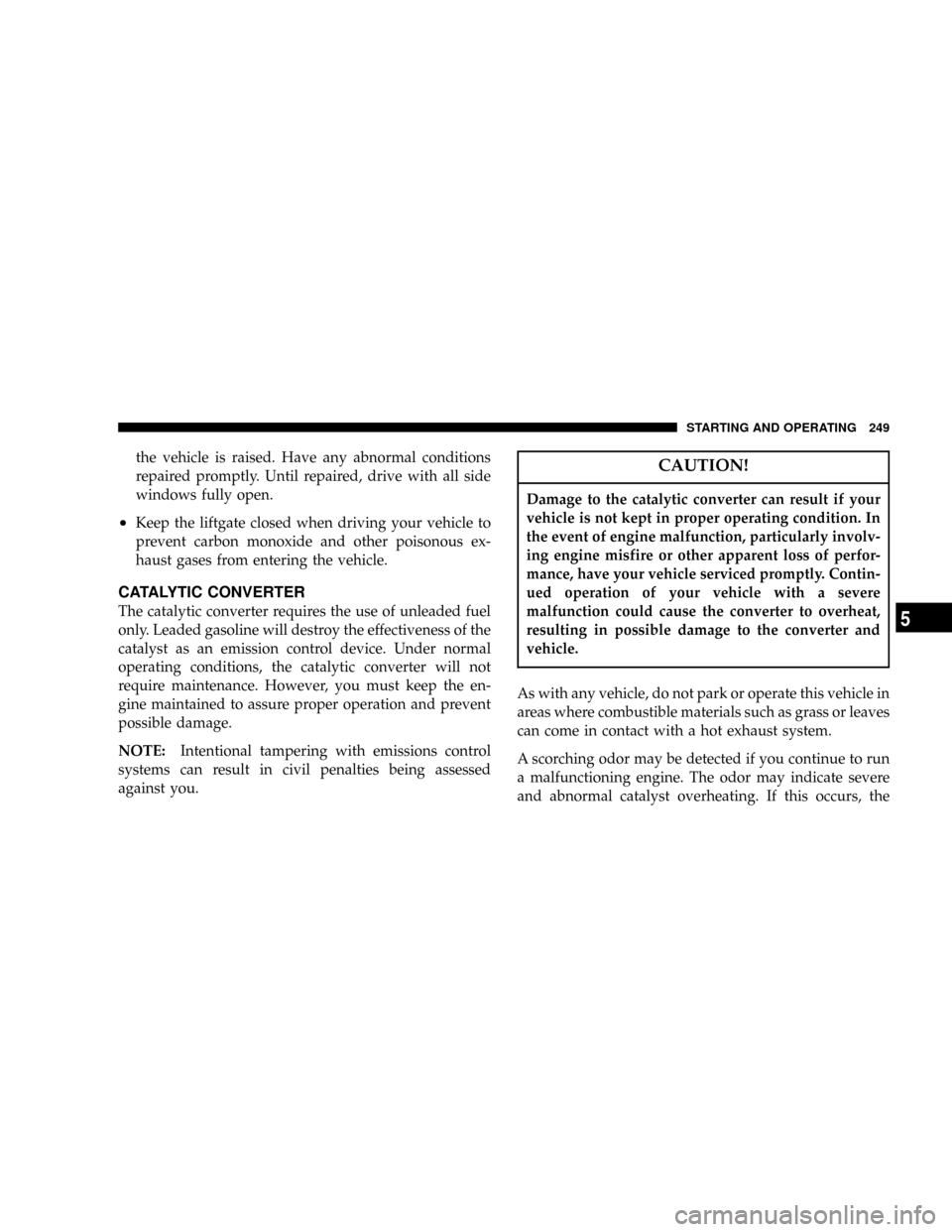maintenance DODGE DURANGO 2004 2.G Owners Manual
[x] Cancel search | Manufacturer: DODGE, Model Year: 2004, Model line: DURANGO, Model: DODGE DURANGO 2004 2.GPages: 386, PDF Size: 6.22 MB
Page 1 of 386

TABLE OF CONTENTSSECTIONPAGE
1INTRODUCTION.............................................................3
2THINGS TO KNOW BEFORE STARTING YOUR VEHICLE..............................7
3UNDERSTANDING THE FEATURES OF YOUR VEHICLE..............................65
4INSTRUMENT PANEL AND CONTROLS.........................................141
5STARTING AND OPERATING.................................................197
6WHAT TO DO IN EMERGENCIES..............................................269
7MAINTAINING YOUR VEHICLE...............................................283
8MAINTENANCE SCHEDULES..................................................339
9IF YOU NEED CONSUMER ASSISTANCE.........................................359
10INDEX....................................................................369
1
2
3
4
5
6
7
8
9
10
Page 4 of 386

INTRODUCTION
This manual has been prepared with the assistance of
service and engineering specialists to acquaint you with
the operation and maintenance of your new vehicle. It is
supplemented by a Warranty Information Booklet and
various customer oriented documents. You are urged to
read these publications carefully. Following the instruc-
tions and recommendations in this manual will help
assure safe and enjoyable operation of your vehicle.
NOTE: After you read the manual, it should be stored
in the vehicle for convenient reference and remain with
the vehicle when sold, so that the new owner will be
aware of all safety warnings.
When it comes to service, remember that your dealer
knows your vehicle best, has the factory-trained techni-
cians and genuine Mopartparts, and is interested in
your satisfaction.WARNING!
Engine exhaust, some of its constituents, and certain
vehicle components contain or emit chemicals
known to the State of California to cause cancer and
birth defects or other reproductive harm. In addition,
certain fluids contained in vehicles and certain prod-
ucts of component wear contain or emit chemicals
known to the State of California to cause cancer and
birth defects or other reproductive harm.
HOW TO USE THIS MANUAL
Consult the table of contents to determine which section
contains the information you desire.
The detailed index, at the rear of this manual, contains a
complete listing of all subjects.
4 INTRODUCTION
Page 68 of 386

NReset Button.........................121
NGlobal Reset.........................121
NStep Button.........................122
NAverage Fuel Economy (AVG ECO)........122
NDistance To Empty (DTE)...............122
NTrip Odometer (ODO)..................123
NElapsed Time (ET).....................123
NC/T Button.........................123
NCompass/Temperature Display...........124
NAutomatic Compass Calibration...........124
NManual Compass Calibration.............124
NTo Put Into a Calibration Mode...........124
NOutside Temperature...................126mGarage Door Opener Ð If Equipped.........126
NProgramming Homelink................128
NCanadian Programming/Gate Programming . . 130
NUsing Homelink......................131
NErasing Homelink Buttons...............131
NReprogramming a Single Homelink Button . . . 132
NSecurity............................132
mPower Sunroof Ð If Equipped.............133
NExpress Open Feature..................133
NWind Buffeting.......................134
NSunroof Maintenance...................135
mElectrical Power Outlets..................135
68 UNDERSTANDING THE FEATURES OF YOUR VEHICLE
Page 135 of 386

the rear windows open, open the front and rear windows
together to minimize the buffeting. If the buffeting occurs
with the sunroof open, adjust the sunroof opening to
minimize the buffeting or open any window.
Sunroof Maintenance
Use only a nonabrasive cleaner and a soft cloth to clean
the glass panel.
ELECTRICAL POWER OUTLETS
This vehicle has three auxiliary power outlets that can
provide up to 20 Amps of current for accessories de-
signed for use with the standard power outlet adapters.
The outlet located in the lower portion of the instrument
panel has a snap on a plastic cap so that it can be covered
when not in use. As a safety precaution, the outlet in the
instrument panel only operates with the ignition switch
ON. When the optional Cigar Lighter heating element isused, it heats when pushed in and pops out automati-
cally when ready for use.To preserve the heating
element, do not hold the lighter in the heating position.
There are two additional 12 V/(20 total Amps for both
outlets) power outlets, one located in the storage bin of
the center console and another located in the right rear
cargo area. These outlets can be reconfigured by the
customer to operate only when the ignition is ON
(switched battery fed) or with the ignition ON or OFF
(battery fed) to allow for cellular telephone charging and
or operation while the ignition is off.
NOTE:All accessories connected to these outlets should
be removed or turned OFF when the vehicle is not in use
to protect the battery against discharge (unless the cus-
tomer has reconfigured the fuse block to switched battery
feed).
UNDERSTANDING THE FEATURES OF YOUR VEHICLE 135
3
Page 142 of 386

NOperation Instructions -
(CD Mode For CD Audio Play)...........165
NLoad/Eject Button
(CD Mode For CD Audio Play)...........166
NNotes On Playing MP3 Files.............168
NOperation Instructions -
(CD Mode For MP3 Audio Play)..........171
NLoad/Eject Button (CD Mode For MP3 Play) . . 171
mSatellite Radio Ð If Equipped..............173
NSystem Activation.....................173
NElectronic Serial Number/Sirius Identification
Number (ENS/SID)....................173
NSelecting Satellite Mode In REF Radios......174
NSelecting Satellite Mode In RAQ Radios.....174NSelecting a Channel....................175
NStoring And Selecting Pre-Set Channels......175
NUsing The PTY (Program Type) Button
(If Equipped)........................175
NPTY Button9Scan9.....................175
NPTY Button9Seek9.....................176
NSatellite Antenna......................176
NReception Quality.....................176
mRemote Sound System Controls Ð If Equipped . . 177
NRadio Operation......................177
NCD Player..........................178
mCompact Disc Maintenance................178
mRadio Operation And Cellular Phones........179
142 INSTRUMENT PANEL AND CONTROLS
Page 178 of 386

The button located in the center of the left hand control
will tune to the next pre-set station that you have
programmed in the radio pre-set push-buttons.
CD Player
Pressing the top of the switch once will go to the next
track on the CD. Pressing the bottom of the switch once
will go to the beginning of the current track or to the
beginning of the previous track if it is within one second
after the current track begins to play.
If you press the switch up or down twice it plays the
second track, three times, it will play the third, etc.
The button in the center of the left hand switch changes
CD's on the 6±Disc in-dash CD changer radio. This
button does not function for all other radios.
COMPACT DISC MAINTENANCE
To keep the compact discs in good condition, take the
following precautions:
1. Handle the disc by its edge; avoid touching the
surface.
2. If the disc is stained, clean the surface with a soft cloth,
wiping from center to edge.
3. Do not apply paper or tape to the disc; avoid scratch-
ing the disc.
4. Do not use solvents such as benzine, thinner, cleaners,
or antistatic sprays.
5. Store the disc in its case after playing.
6. Do not expose the disc to direct sunlight.
7. Do not store the disc where temperatures may become
too high.
178 INSTRUMENT PANEL AND CONTROLS
Page 241 of 386

TIRE ROTATION RECOMMENDATIONS
Tires on the front and rear axles of vehicles operate at
different loads and perform different steering, driving,
and braking functions. For these reasons, they wear at
unequal rates and tend to develop irregular wear pat-
terns. These effects can be reduced by timely rotation of
tires. The benefits of rotation are especially worthwhile
with aggressive tread designs such as those on all season
type tires. Rotation will increase tread life, help to main-
tain mud, snow and wet traction levels, and contribute to
a smooth, quiet ride.
Follow the recommended tire rotation frequency for your
type of driving found in the ªMaintenance Schedulesº
Section of this manual. More frequent rotation is permis-
sible if desired. The reasons for any rapid or unusual
wear should be corrected prior to rotation being per-
formed.
STARTING AND OPERATING 241
5
Page 249 of 386

the vehicle is raised. Have any abnormal conditions
repaired promptly. Until repaired, drive with all side
windows fully open.
²Keep the liftgate closed when driving your vehicle to
prevent carbon monoxide and other poisonous ex-
haust gases from entering the vehicle.
CATALYTIC CONVERTER
The catalytic converter requires the use of unleaded fuel
only. Leaded gasoline will destroy the effectiveness of the
catalyst as an emission control device. Under normal
operating conditions, the catalytic converter will not
require maintenance. However, you must keep the en-
gine maintained to assure proper operation and prevent
possible damage.
NOTE:Intentional tampering with emissions control
systems can result in civil penalties being assessed
against you.
CAUTION!
Damage to the catalytic converter can result if your
vehicle is not kept in proper operating condition. In
the event of engine malfunction, particularly involv-
ing engine misfire or other apparent loss of perfor-
mance, have your vehicle serviced promptly. Contin-
ued operation of your vehicle with a severe
malfunction could cause the converter to overheat,
resulting in possible damage to the converter and
vehicle.
As with any vehicle, do not park or operate this vehicle in
areas where combustible materials such as grass or leaves
can come in contact with a hot exhaust system.
A scorching odor may be detected if you continue to run
a malfunctioning engine. The odor may indicate severe
and abnormal catalyst overheating. If this occurs, the
STARTING AND OPERATING 249
5
Page 254 of 386

TRAILER TOWING
To maintain warranty coverage, follow the requirements
and recommendations in this manual concerning ve-
hicles used for trailer towing.
Definitions
The following trailer towing related terminology defini-
tions will assist in understanding the subsequent sec-
tions:
GROSS COMBINATION WEIGHT RATING (GCWR)
is the total permissible weight of your vehicle and trailer
when weighed in combination. (Note that GCWR ratings
include a 68 kg (150 lb.) allowance for the presence of a
driver.) Tongue Weight (of a trailer) is the weight placed
on a vehicle's trailer hitch by the trailer.
GROSS TRAILER WEIGHT (GTW)is the weight of the
trailer plus the weight of all cargo, consumables and
equipment (permanent or temporary) loaded in or on the
trailer in its9loaded and ready for operation9condition.TRAILER SWAY CONTROLis a telescoping link that
can be installed between the hitch receiver and the trailer
tongue that typically provides adjustable friction associ-
ated with the telescoping motion to dampen any un-
wanted trailer swaying motions while traveling.
CAUTION!
²During the first 500 miles (805 km) your new
vehicle is driven, do not tow a trailer. Doing so
may damage your vehicle.
²When first towing a trailer, limit your speed to 50
mph (80 km/h) during the first 500 miles (805 km)
of towing.
Perform the maintenance listed in Section 8 of this
manual. When towing a trailer, never exceed the GAWR,
or GCWR, ratings.
254 STARTING AND OPERATING
Page 261 of 386

²Highway Driving
Reduce speed.
²Air Conditioning
Turn off temporarily.
²See Cooling System Operating information in the
Maintenance section of this manual for more informa-
tion.
To reduce potential for automatic transmission overheat-
ing, turn the ªTOW/HAULº feature on when driving in
hilly areas or shift the transmission to Drive position 2 on
more severe grades. Move the shift lever to the next
lower position to eliminate excessive transmission shift-
ing. This action will also reduce the possibility of trans-
mission overheating and provide better engine braking.
SNOWPLOW
Dodge Durango Models
NOTE:Do not use Dodge Durango Models for snow-
plow applications.
WARNING!
Snowplows, winches, and other aftermarket equip-
ment should not be added to the front end or your
vehicle. The airbag crash sensors may be affected by
the change in the front end structure. The airbags
could deploy unexpectedly or could fail to deploy
during a collision resulting in serious injury or
death.
STARTING AND OPERATING 261
5